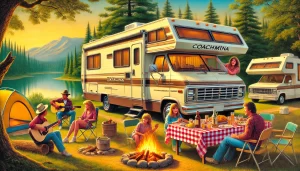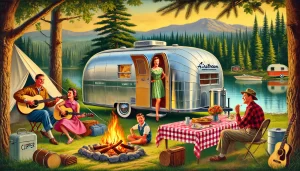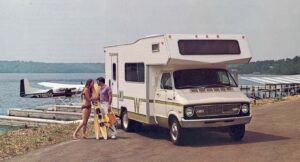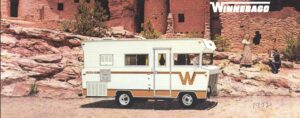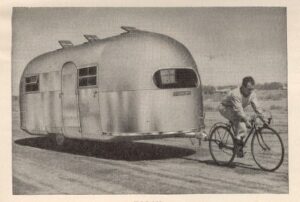The Airstream RV Company in 1948: A Year of Innovation and Expansion
New Features and Design Changes in 1948
In 1948, the Airstream RV Company introduced several exciting new features and design changes to their lineup. One notable addition was the inclusion of turn signals as a standard feature, reflecting the changing regulations across different states that required these safety measures. This enhancement ensured that Airstream trailers were compliant with the evolving road safety standards.
Design-wise, Airstream incorporated birch cabinetry into their trailers, lending a touch of elegance and warmth to the interior spaces. Overhead cabinets with birch doors became a popular feature, providing ample storage space for travelers’ belongings. The use of stainless steel galley assembly and ice-box added a modern touch while catering to the practical needs of travelers.
Price Changes and Market Strategy
In 1948, the Airstream RV Company adjusted its pricing strategy to align with market demands and economic factors. The cost of Airstream trailers varied based on the model and size, with the 22′ Liner typically falling into the 1000 series. These price adjustments aimed to cater to different budgets while ensuring that customers could experience the quality and craftsmanship that defined the Airstream brand.
Airstream strategically positioned its trailers as a premium option in the market, emphasizing their durability, innovative design, and reputation for high-quality construction. The company focused on highlighting the unique features and benefits of Airstream trailers, targeting adventure seekers, road trip enthusiasts, and families looking for a comfortable and stylish way to explore the country.
Expanded Product Lines and Model Offerings
In 1948, Airstream expanded its product lines, offering a range of models to suit diverse customer preferences. Among the popular models available during this year were the Southwind, Breeze, Chinook, Tradewind, Westwind, Zephyr, and Sea Breeze. Each model boasted its own unique characteristics, catering to different lifestyles and travel needs.
The Airstream Liner, with its spacious layout and comfortable amenities, garnered significant attention. Customers were drawn to the versatility and practicality of the Liner, making it a sought-after choice for individuals and families embarking on road trips or seeking temporary accommodations.
Serial Number Information and Collectability
In 1948, Airstream continued its sequential serial numbering system for different model lengths. The 22′ Liner typically fell into the 1000 series, signifying its place in the Airstream lineup. This numbering system not only facilitated tracking and inventory management for the company but also contributed to the collectibility of these vintage trailers today.
The 1948 Airstream Liner, with its distinct serial number within the 1000 series, holds a special place in the hearts of collectors and enthusiasts. Owning a piece of Airstream history from this specific year allows individuals to connect with the past, relishing in the craftsmanship and design details that made these trailers unique during that era.
Marketing Efforts and Brand Recognition
Airstream placed significant emphasis on marketing in 1948, aiming to strengthen its brand recognition and expand its customer base. The company utilized various channels, including print advertisements in magazines, brochures, and direct mail campaigns, to showcase the features, design innovations, and lifestyle benefits of Airstream trailers.
The marketing materials highlighted the freedom, adventure, and camaraderie associated with Airstream ownership. Vibrant images of families enjoying the open road, coupled with persuasive copy, aimed to evoke a sense of wanderlust and inspire potential customers to embark on their own Airstream journey.
Airstream also actively participated in trade shows, fairs
and exhibitions to showcase their trailers to a wider audience. These events provided an opportunity for people to see the Airstream trailers up close, experience their quality craftsmanship, and interact with knowledgeable staff who could answer their questions.
The Airstream RV Company also fostered partnerships with dealerships and distributors across the country to expand its market reach. One notable collaboration was with McFaul Brothers, whose “McFaul Bros Trailer Sales” played a crucial role in retailing Airstream trailers at their sales lot. This partnership allowed Airstream to tap into McFaul Brothers’ expertise and established customer base, further strengthening the brand’s presence in the market.
Furthermore, word-of-mouth played a significant role in Airstream‘s marketing efforts. Satisfied customers became brand ambassadors, sharing their positive experiences and adventures with Airstream trailers. This organic promotion helped build trust and credibility, making Airstream a recognized and respected name in the RV industry.
In conclusion, the year 1948 marked a significant period for the Airstream RV Company. It was a time of innovation, with the introduction of new features such as turn signals and stylish design elements like birch cabinetry. Airstream expanded its product lines, offering a range of models to cater to different customer preferences. The company’s marketing efforts focused on highlighting the unique benefits of Airstream trailers, targeting adventure seekers and road trip enthusiasts. The sequential serial numbering system added collectability to the 1948 Airstream Liner, making it a prized possession for vintage RV enthusiasts. Through strategic marketing initiatives and partnerships, Airstream increased its brand recognition and solidified its position as a leader in the industry. The year 1948 serves as a testament to Airstream‘s commitment to innovation, quality, and the pursuit of adventure on the open road.


